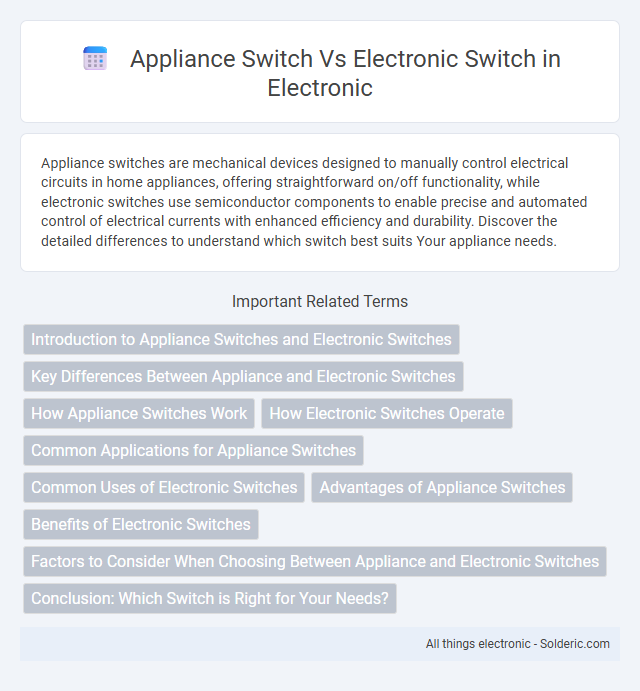Appliance switches are mechanical devices designed to manually control electrical circuits in home appliances, offering straightforward on/off functionality, while electronic switches use semiconductor components to enable precise and automated control of electrical currents with enhanced efficiency and durability. Discover the detailed differences to understand which switch best suits Your appliance needs.
Comparison Table
| Feature | Appliance Switch | Electronic Switch |
|---|---|---|
| Functionality | Manually controls power to appliances | Controls power using electronic signals |
| Operation | Mechanical ON/OFF toggle | Solid-state switching (transistors, MOSFETs) |
| Durability | Prone to mechanical wear | Longer life with no physical wear |
| Speed | Slower switching speed | High-speed switching (microseconds) |
| Applications | Home appliance power control | Industrial controls, automation, digital circuits |
| Power Consumption | Negligible | Low power required for switching |
| Cost | Lower initial cost | Higher cost due to complexity |
| Control Type | Manual control | Automated or remote control |
Introduction to Appliance Switches and Electronic Switches
Appliance switches are mechanical devices designed to control the flow of electricity in household and industrial equipment, providing reliable manual on/off operation with physical contacts. Electronic switches use semiconductor components such as transistors or thyristors to regulate current electronically, enabling faster switching, reduced wear, and integration into automated systems. These differences impact durability, control precision, and application versatility across various electrical and electronic devices.
Key Differences Between Appliance and Electronic Switches
Appliance switches are mechanical devices designed to control power flow in household appliances, featuring physical toggles or buttons, whereas electronic switches use semiconductor components like transistors to manage electrical signals without moving parts. Electronic switches offer faster switching speeds, higher reliability, and greater energy efficiency compared to appliance switches, which are more prone to wear and tear due to their mechanical nature. Understanding these key differences helps you select the most appropriate switch type for your application, ensuring optimal performance and durability.
How Appliance Switches Work
Appliance switches operate through mechanical contacts that open and close an electrical circuit, allowing current to flow to a device or interrupting it to turn the device off. These switches rely on physical movement, such as toggling or pressing, to make or break the connection, which provides a simple, reliable means of controlling household appliances. Your choice between an appliance switch and an electronic switch depends on factors like durability, noise level, and the specific control needs of the appliance.
How Electronic Switches Operate
Electronic switches operate by utilizing semiconductor devices such as transistors, thyristors, or MOSFETs to control electrical current flow with high precision and speed. These switches function by modulating voltage or current signals to turn circuits on or off without mechanical movement, enabling silent operation and extended durability. Their ability to switch rapidly and efficiently makes them ideal for applications in power electronics, signal processing, and automation systems.
Common Applications for Appliance Switches
Appliance switches are primarily used in household devices such as microwave ovens, washing machines, and refrigerators, where reliable mechanical control is essential. These switches handle higher loads and provide tactile feedback, making them suitable for appliances requiring manual operation or safety interlocks. Their robustness and simplicity ensure consistent performance in everyday consumer electronics and kitchen equipment.
Common Uses of Electronic Switches
Electronic switches are widely used in digital circuits, including microprocessors and communication devices, to control signal flow with high precision. They are essential in applications such as timing circuits, power management, and switching regulators where fast response and reliability are critical. Unlike appliance switches, electronic switches enable automation and integration in complex electronic systems like smartphones, computers, and industrial controls.
Advantages of Appliance Switches
Appliance switches offer robust durability and reliability, making them ideal for heavy-duty applications where frequent On/Off operations are required. Their simple mechanical design ensures easy installation and maintenance, reducing downtime and repair costs. You benefit from better electrical isolation and enhanced safety due to their physical separation of contacts, minimizing the risk of electrical faults.
Benefits of Electronic Switches
Electronic switches offer precise control and faster response times compared to traditional appliance switches, enhancing the efficiency of your electrical devices. They are more durable with fewer moving parts, reducing wear and maintenance needs while enabling advanced features like remote operation and automation. These switches also improve energy savings by optimizing power usage through smart technology integration.
Factors to Consider When Choosing Between Appliance and Electronic Switches
When selecting between appliance switches and electronic switches, consider factors such as load capacity, switching speed, and durability. Appliance switches typically handle higher electrical loads and are suited for heavy-duty applications, while electronic switches offer faster response times and greater precision for sensitive electronics. Evaluate environmental conditions, including temperature and humidity, as electronic switches may be more sensitive to these factors compared to rugged appliance switches.
Conclusion: Which Switch is Right for Your Needs?
Choosing between an appliance switch and an electronic switch depends on your specific application requirements and environment. Appliance switches offer durability and simplicity, ideal for heavy-duty or high-current devices, while electronic switches provide precise control, faster response times, and integration with smart home systems. Evaluate factors such as load capacity, control complexity, and compatibility with your existing setup to determine the best switch for your needs.
Appliance switch vs Electronic switch Infographic

 solderic.com
solderic.com